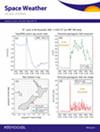Variability of Ionosphere Over Indian Longitudes to a Variety of Space Weather Events During December 2006
IF 3.7
2区 地球科学
引用次数: 0
Abstract
This paper highlights the impact of intense solar events over India during 3–20 December 2006. Ionospheric effects of a major solar flare (X9) on December 5 (10:35 UT) have been investigated by using dayside and nightside magnetometer data, dayside ionosondes, and dayside GPS vTEC observations. On the next day, a stream of fast solar wind hits the magnetosphere, causing a HILDCAA (High Intensity Long Duration Continuous Auroral Activity) preceded by moderate geomagnetic storm. The origin and characteristics of a positive ionospheric storm which occurred over Tirunelveli (TIR, geomagnetic latitude: −0.18°N) in the recovery phase of storm due to simultaneous presence of enhanced O/N2 and WEJ or weakened EEJ during the HILDCAA (7th and 8th of December) is investigated. Subsequently, on December 14, the most powerful CME since the Halloween event impacts the Earth, and three SSCs are recorded on December 14, 16, and 18. The variability of the ionosphere over the Indian longitude sector due to these intense space weather fluctuations is presented by utilizing the magnetometers, ionosonde, GPS vTEC, and satellite-based observations in the same region. This study reports the influence of prompt penetration of the magnetospheric convection electric field and the disturbance dynamo on several key ionospheric and magnetic parameters within the Indian longitude sector.2006年12月印度经度电离层对各种空间天气事件的变化
本文重点介绍了2006年12月3日至20日期间强烈太阳活动对印度的影响。利用日侧和夜侧磁强计、日侧电离层探空仪和日侧GPS vTEC观测资料,研究了12月5日(10:35 UT)一次大型太阳耀斑(X9)的电离层效应。第二天,一股快速的太阳风击中磁层,引起了HILDCAA(高强度长时间连续极光活动),随后是中度地磁风暴。研究了12月7日和8日HILDCAA期间,由于O/N2和WEJ同时增强或EEJ减弱,在风暴恢复阶段发生在Tirunelveli (TIR,地磁纬度:−0.18°N)上空的一次正电离层风暴的起源和特征。随后,在12月14日,自万圣节事件以来最强大的日冕物质抛射撞击地球,在12月14日、16日和18日记录了三个超强太阳风暴。利用磁力计、电离层探空仪、GPS vTEC和卫星在同一地区的观测,呈现了印度经度扇区电离层由于这些强烈的空间天气波动而产生的变化。本文报道了磁层对流电场的迅速穿透和扰动发电机对印度经度扇区内几个关键电离层和磁参数的影响。
本文章由计算机程序翻译,如有差异,请以英文原文为准。
求助全文
约1分钟内获得全文
求助全文

 求助内容:
求助内容: 应助结果提醒方式:
应助结果提醒方式:


